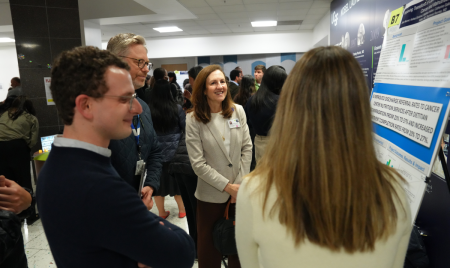White Fragility in Academic Medicine

Photo by Susan Merrell
In 2018, Drs. Mengesha, Hill, and Autry implemented a Microaggressions Grand Rounds series in the Department of Obstetrics, Gynecology, and Reproductive Sciences at UCSF. The purpose of this series was to foster ongoing departmental dialogue on bias and inequity in patient care, learning environments, and workplace culture. There was an intentional focus on developing strategies to generate accountability towards creating an anti-oppressive departmental climate. This series has included topics such as Microaggressions in the Learning Environment, Navigating Expressed Bias and Racism between Patient and Provider, and Stereotype Threat and Bias in Learner Assessment.
Most recently the Grand Rounds topic was White Fragility in Academic Medicine. The discussion opened with an explicit acknowledgment that focusing on white fragility is seemingly hypocritical to antiracism work, as those who identify as white are responsible for engaging in critical self-reflection and as centering on the needs of white-identified individuals reinforces systems of power and privilege. However, Drs. Mengesha, Hill, and Autry felt this was an important discussion to have within the predominately-white department to disrupt the status-quo of avoiding white discomfort (or bending to white fragility) and to raise individual and collective awareness to engage in antiracist work.
White fragility, a term coined by Dr. Robin DiAngelo (a white-identified sociologist and author of the book “White Fragility”), involves decreased capacity to tolerate racial stress that in turn triggers defensive actions and behaviors. It is important to understand the concepts of whiteness, white privilege, and white supremacy before trying to understand white fragility. Race is a social construct and was built solely to provide social and economic rights and benefits to white men during the creation of our country in the context of colonization, genocide, and slavery. Aided by various systems of oppression, whiteness is centered in a manner that defines it as normative and creates a universal point of reference. Anything outside of whiteness, such as people of color and their unique reference point, is a deviation from the norm. This results in whiteness often being invisible to those who identify as white, while being deeply embedded into the very fabric of our society and institutions.
White privilege is built upon whiteness and is a legacy of racism and bias that created unearned benefits and advantages for white people. White privilege does not imply that white people have not endured their own personal struggles, but instead acknowledges the systemic benefits they enjoy because of our social structure. White privilege allows white individuals to walk through the world with the assumption that their needs will be readily met and that they will be given the benefit of the doubt.
White supremacy ensures the perpetuation and livelihood of white privilege. White supremacy does not only refer to white nationalists or the Ku Klux Klan, but instead refers to the overarching social, economic, and political structure that assumes the superiority of white people. It is invisibly woven into every part of our major societal structures and ensures centrality of the needs of and benefits for white people.
Despite the overwhelming evidence of disparities and discrimination against racial and ethnic minorities, some white Americans believe that the increased attention to and engagement in antiracist work is resulting in an anti-white bias. Challenges to racism, particularly in liberal environments, are reduced to equating racism with immorality or justification for why certain white people are not part of the problem because of their own individual oppressions such as growing up poor, being an immigrant, or being a woman.
A byproduct of the racial insulation that whiteness, white privilege, and white supremacy provide to white people with respect to interacting with racial stress and triggers, white fragility results when the equilibrium of whiteness and white privilege is challenged. This fragility can manifest as anger, fear, guilt, silence, withdrawal, or the physical removal of oneself from a situation or conversation. White fragility thus functions to silence people of color, prevent any engagement in discussions of race, redirect more resources towards white people, and restore the racial equilibrium back to centering white people.
White fragility, white privilege, and white supremacy show up in multiple ways in academic medicine through the inability to explore the role of white supremacy culture in clinical and training environments, thus invalidating the lived experiences of marginalized groups. Academic medicine requires that any change to its current structures, many of which are rooted in a legacy of racism, have “big data” or NIH-level grants as proof or validation for change, thus perpetuating inequity. White fragility shows up in academic medicine with the devaluation of antiracist work that does not hold the same academic currency as NIH-funded research – effectively taking race off the “academic table.”
DiAngelo claims that white progressives cause the most damage to people of color because they believe they “have arrived,” thus centering themselves and misdirecting their energy into ensuring that others see that they “have arrived” instead of engaging in ongoing self-awareness, relationship building, and true anti-racist practice. When challenged, white progressives uphold and perpetuate racism through their fragility and continued efforts to center their needs in any conversation about race. The multiple requests we have received to write and present about this topic after our recent grand rounds (compared to the paucity of requests we received after our presentations that were centered on people of color) is a great example of white fragility and centering the needs of white people.
Essentially, white fragility protects racism. In antiracist work, naming white fragility is entirely the duty of white allies; it is not the job of people of color to give white people racial feedback and education. People of color have for too long shouldered the burden of needing to advance the antiracist discourse forward among their white counterparts, which can be incredibly unsafe and exhausting. White people need to hold each other accountable to changing their racial model through strategies like participating in white caucuses where they can explicitly and intentionally work together on: examining white privilege, white supremacy, and racism; deepening capacity for racial allyship; and, strengthening critical self-reflection skills with respect to participation in all levels and forms of racism.
White people must remove themselves from the center of the conversation when engaging in anti-racist work and use their privilege to advocate for people of color to be at the center and lead. The historical racist legacies of academic medicine that allow for white privilege, white supremacy, and white fragility to flourish need to be dismantled in order to move towards a racially equitable environment and profession.
References:
- White Fragility in Academic Medicine Grand Rounds 12/17/19
- White Fragility, Robin DiAngelo Beacon Press June 2018.
- Tema Okun and Kenneth Jones, Dismantling Racism Workbook 2001
- “Discrimination in America”. National Public Radio, Robert Wood Johnson Foundation, Harvard TH Chan School of Public Health, 2017.
Faculty:
- Biftu Mengesha, MD, MAS is the Associate Director of Innovating Education in Reproductive Health, Assistant Residency Program Director in the Department of Obstetrics and Gynecology UCSF, and a Watson’s Scholar
- LaMisha Hill, PhD is the Director of Multicultural Affairs in the Office of Diversity and Outreach, UCSF
- Meg Autry, MD is the Residency Director in the Department of Obstetrics and Gynecology UCSF and a sustaining member of the Academy









